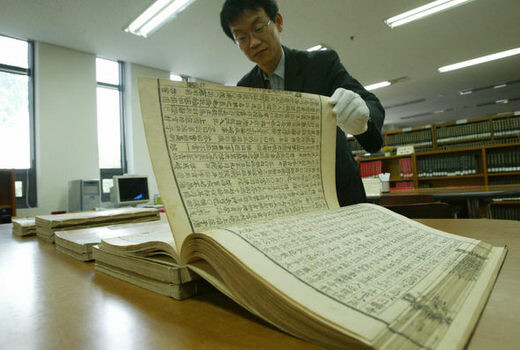hankyoreh
Links to other country sites 다른 나라 사이트 링크
[Editorial] Private groups win return of Korean artifacts

Forty-seven volumes from the Mount Odae edition of the "Annals of the Joseon Dynasty" (Joseon wangjo sillok) are returning to Korea after having been taken by an imperialist Japan 93 years ago. The format of the return leaves one very uncomfortable, because it is classified as a "donation" by Tokyo University to Seoul National University. Yet, one can somewhat understand Tokyo University’s "packaging" the agreement as such, out of concern for the possible reaction from Japanese right-wingers. But it should be noted that the return is an accomplishment on the part of the Korean Buddhist community and civic groups, rather than the government.
The volumes suffered more by the hand of Japan than many other Korean cultural assets. During the Japanese invasion of 1592, the editions kept in Seoul, Chungju, and Seongju were all burned; only the Jeonju edition survived. Later, the Joseon court ordered four more sets made from the Jeonju edition, and archived them in centers in Ganghwa, Mount Taebaek, Mount Odae, and Muju. The Mount Odae edition was sent to Japan by the first Japanese governor-general in Korea, Terauchi Masatake. Only 74 of its 1,000 volumes survived the Great Tokyo Fire that followed the Kanto Earthquake of 1923. Of those, 27 were returned to Korea in 1932.
The return of the Mount Odae edition is even more noteworthy in that it establishes a new model for the return of plundered cultural properties. Members of the Buddhist community, including the abbot of the temple responsible for the archive center at Mount Odae, along with a civic group, joined forces and formed the "Committee for the Return of the Annals of the Joseon Dynasty" and began to pressure the Japanese government and Tokyo University. There had been two rounds of negotiations already involving the volumes, and a third round was scheduled, thanks to the group’s efforts.
Since it was a non-governmental group that was involved, they were able to avoid the issues of national pride and diplomatic friction that might have resulted had Seoul gotten involved. Furthermore, the decision by the Park Chung Hee regime to promise Japan (as part of the Korea-Japan Treaty of 1964) that Korea would stop demanding the return of cultural properties makes the Korean government’s position more difficult in this kind of situation.
On the occasion of this beautiful accomplishment, we express our hope that nongovernmental groups will lead the way in winning the return of plundered cultural properties and that the government will actively back them up. Even if you count only confirmed cases, there are 74,434 Korean cultural artifacts overseas, with 46 percent of those in Japan.
Editorial・opinion
![[Guest essay] The real reason Korea’s new right wants to dub Rhee a founding father [Guest essay] The real reason Korea’s new right wants to dub Rhee a founding father](https://flexible.img.hani.co.kr/flexible/normal/500/300/imgdb/original/2024/0423/8317138574257878.jpg) [Guest essay] The real reason Korea’s new right wants to dub Rhee a founding father
[Guest essay] The real reason Korea’s new right wants to dub Rhee a founding father![[Column] ‘Choson’: Is it time we start referring to N. Korea in its own terms? [Column] ‘Choson’: Is it time we start referring to N. Korea in its own terms?](https://flexible.img.hani.co.kr/flexible/normal/500/300/imgdb/original/2024/0423/3617138579390322.jpg) [Column] ‘Choson’: Is it time we start referring to N. Korea in its own terms?
[Column] ‘Choson’: Is it time we start referring to N. Korea in its own terms?- [Editorial] Japan’s rewriting of history with Korea has gone too far
- [Column] The president’s questionable capacity for dialogue
- [Column] Are chaebol firms just pizza pies for families to divvy up as they please?
- [Column] Has Korea, too, crossed the Rubicon on China?
- [Correspondent’s column] In Japan’s alliance with US, echoes of its past alliances with UK
- [Editorial] Does Yoon think the Korean public is wrong?
- [Editorial] As it bolsters its alliance with US, Japan must be accountable for past
- [Guest essay] Amending the Constitution is Yoon’s key to leaving office in public’s good graces
Most viewed articles
- 1[Column] ‘Choson’: Is it time we start referring to N. Korea in its own terms?
- 2Senior doctors cut hours, prepare to resign as government refuses to scrap medical reform plan
- 3[Guest essay] The real reason Korea’s new right wants to dub Rhee a founding father
- 4Why Korea shouldn’t welcome Japan’s newly beefed up defense cooperation with US
- 5Opposition calls Yoon’s chief of staff appointment a ‘slap in the face’
- 6New AI-based translation tools make their way into everyday life in Korea
- 7Terry Anderson, AP reporter who informed world of massacre in Gwangju, dies at 76
- 8[Column] The clock is ticking for Korea’s first lady
- 9Samsung barricades office as unionized workers strike for better conditions
- 10Korean government’s compromise plan for medical reform swiftly rejected by doctors